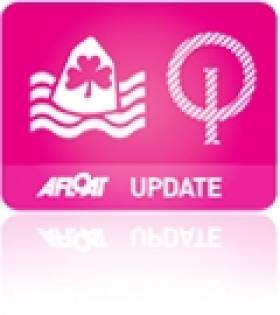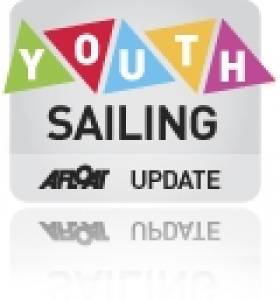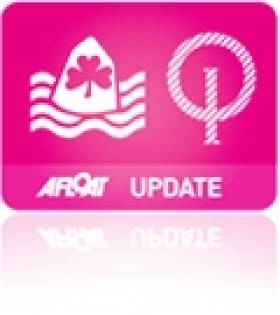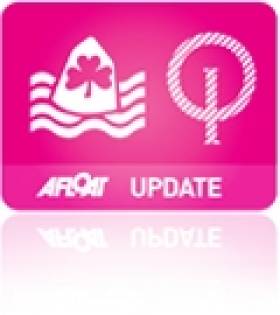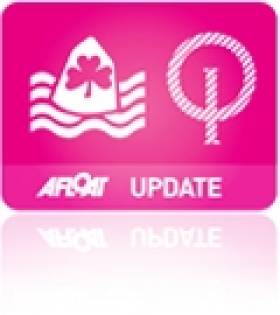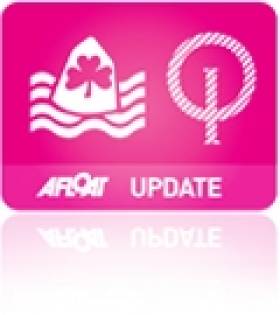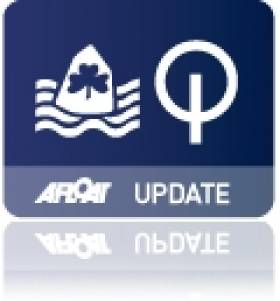Displaying items by tag: Optimist
Durcan Counts OCS In First Race of CH Marine Optimist Championships
#optimist – The scene was set at Royal Cork Yacht Club this morning when some 190 competitors took to the water for the first day of racing at the CH Marine Irish Optimist National Championships writes Claire Bateman. The adrenaline fueled young sailors were champing at the bit in their eagerness to get to sea to commence battle. At the launch scene with all the volunteer helpers involved and with the different accents and the varying languages resounding in the morning air, it could have been likened to the tower of babel. The slick preparations and procedures put into place by the host club were well evident and the large number of optimist dinghies took smoothly to the water and on their way to the race area. The Senior and Junior fleets headed to Ringabella with the Regatta fleet younger sailors remaining comfortably closer to home on the Curlane Bank. The beauty of Cork harbour for sailing in any type of weather conditions is well known and the variety of courses available to choose to suit such conditions is second to none.
The weather proved to be in a slightly disobliging mood only providing 6 to 8 knots of a north westerly wind, other times rising to 12 knots and then dying away to 2 or 3. However, Race Officer David O'Brien got the Junior fleet underway followed by the Seniors and Race 1 was duly completed with the shock result of an OCS for Harry Durcan RCYC . However, whilst waiting for Race 2 to follow, the weather mood suddenly changed and the heavens opened with an almost biblical like deluge. This duly passed over and then a change of wind direction forced a relaying of some marks with ensuing delays due to the changeable breeze. Patience persevered and Race 2 finally got under way with an excellent win for Durcan who had suffered an OCS in Race 1. Harry will be our sole Irish Optimist at the forthcoming World Optimist Championship in Buenos Aires.
The Regatta fleet in the safe hands of Race Officer Eddie Rice, sailed on the Curlane Bank and experienced the same deluge before it arrived with the Junior and senior fleets. Racing went very smoothly and it was good to see the smiling faces of the sailors arriving back at the club delighted they had been able to sail two races in spite of the light winds. A tribute indeed to David O'Brien and Eddie Rice with their race teams.
Racing continues tomorrow and hopefully we will see a little more of a steady breeze.
Results here
#optimists – 200 Optimist sailors gathered at Royal Cork Yacht Club for the Opening Ceremony of the CH Marine Irish Optimist National Championships to be raced in Cork Harbour this weekend writes Claire Bateman.
The ceremony was preceded by a parade of competitors with flags from the dinghy park to the club house. The atmosphere was electric with the excited young competitors milling around on a glorious sunny evening. The flags were flying, Crosshaven was looking at its best, registration and checking of certificates and sail measurement was attracting long queues. The competitors and their families were welcomed by MC for the evening, Optimist Class Captain Rob Foster. Admiral Pat Lyons then spoke and also welcomed the competitors many of whom had come from the four corners of Ireland. A large contingent travelled from the U.K. and competitors also came from Spain, Italy and Bermuda, as well as a squad from India.
The Admiral then turned to a particularly significant part of the evening which was the Royal Cork Yacht Club recognition of the outstanding achievement of well known and very popular club member Séafra Guilfoyle who recently represented the club with honour at the highest level in international dinghy sailing. In July Séafra took silver in the Laser Radial Class at the ISAF Youth Worlds in Tavira, Portugal. This was only the third time an Irish sailor had achieved a podium position at an ISAF Youth World Championship and a first for a Royal Cork sailor. Seafra won Afloat's Sailor of the Month for July for his endeavours.
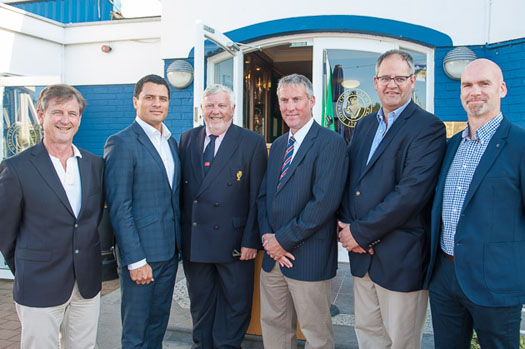
(From L. to R) Nick Bendon, CH Marine, Doug Howlett, Admiral Pat Lyons, Optimist Class Captain Rob Foster. Aidan Staunton, President IODAI and Martin O'Donovan CH Marine. Photo: Robert Bateman
It is worth noting that it was only a short six years since Séafra was competing in the Oppie Nationals having come up through the ranks before moving on to the Laser Radial. The Admiral then made a presentation to Séafra on behalf of the club and this was greeted with rousing applause from the assembled gathering.
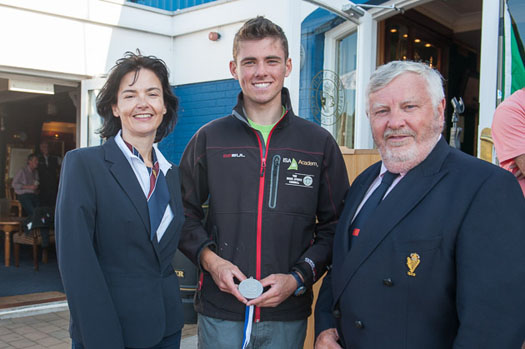
Rear Admiral Dinghies, Celine Mc Grath, Séafra Guilfoyle and Admiral Pat Lyons Photo: Robert Bateman
The IODAI President, Aidan Staunton also spoke and wished the competitors the very best of competition for the event. Also present in the official welcoming party were principal sponsor for the event Nick Bendon of CH Marine and his CH Marine colleague Martin O'Donavan.
Then came the moment of the evening all the youngsters and rugby fans had been awaiting, the legendary Doug Howlett addressed the gathering to a rapturous reception and then declared the CH Marine Irish Optimist National Championship to be officially open. He proved to be a huge hit with the gathering and was a very popular choice to perform the official opening. When he had finished speaking he was surrounded by young sailors who were very proud to be seen walking around the club with the backs of their t-shirts bearing the signature of the rugby ace.
All in all a very successful and enjoyable evening.
#optimist – Royal Cork's Harry Durcan leads the Irish charge in 22nd place at the halfway mark of a massive 173–boat Optimist British & Open National Championships.
There were strong winds with gusts up to 23 knots created challenging condition for Optimist sailors today off Weymouth.
A grey, overcast morning gave way to sunshine in the afternoon along with a minor decrease in wind strength, however despite a slightly calmer afternoon, day three of racing proved to be the toughest yet for all fleets.
It was a great day for the Senior Fleet (Main), all of whom were challenged by big swells in Weymouth Bay. There was one general recall across three races and overall slow progress to the windward mark due to the choppy waves, however once the sailors rounded the top mark they took off on the reach and flew downwind very quickly. The leaders were the more experienced sailors in the fleet, and they managed to put a good distance between themselves and the rest of the pack.
While the international competition is doing very well, Vita Heathcote, 13 (Royal Lymington Yacht Club) who had a strong day, is sitting in third place and is the top British sailor sailor in the Senior Fleet. Also in the top ten are Arthur Fry, 13 (Royal Lymington Yacht Club) and Hatty Morsley, 15 (Port Dinorwic Sailing Club).
Arthur described the day, "It was pretty windy out in the bay and quite shifty, but it was a great day sailing and I'm pretty pleased to have moved into 8th overall."
Hattie continued, "The strong winds today made it very hard work, but it was also rewarding and there is good competition in the fleet. I managed to get my tactics right and finished with a 5, 15 and 10."
The Junior Fleet (Main) had similar conditions with slightly less chop inside the harbor. They completed three good races with no general recalls. The first race proved to be the toughest with the most wind, favoring the heavier sailors. Between 10 to 12 boats retired from the first race, however there were no major incidents aside from a few capsizes.
A British sailor has moved into first place for the first time in this event in the main – fleet, Alexandra Schonrock, 12 (Parkstone Yacht Club) leads before both the Senior and Junior fleets split into gold and silver tomorrow.
Regatta Fleet racing was especially challenging for the young sailors. The race committee managed two races in the morning and three in the afternoon. The first race of the day took a toll on the fleet and there were a number of capsizes and non-finishers. Slightly less wind in the afternoon meant more sailors were able to get around the course.
The Regatta Coached Fleet had two races in top end of conditions. There was determination among the regatta fleet sailors to get around the course and finish and everyone came back to shore with accomplished smiles on their faces.
The forecast for tomorrow is for lighter winds, between 11 to 13 knots with racing scheduled to resume tomorrow [Wednesday 6 August] at 11.00 AM.
For full results and more information, here
#optimist – Anyone looking at the 254 young sailors – mostly thirteen to fifteen year olds – milling around at the closing ceremony of the recent Optimist European Championships in Dun Laoghaire on Dublin Bay last weekend might wonder what future participation in sailing holds for them writes David O'Brien.
No crystal ball is available but it is possible to research with the help of Google what has happened to their opposite numbers of ten years ago, the participants in the championship of 2004 held in Sandhamn in Sweden. What follows is the result of such research seen by Afloat.ie into a random 20% sample of those sailors.
From the start it must be said that these 2004 sailors were already an 'elite'. They had qualified at national level on the basis of trials almost always involving over a hundred contemporaries and in larger countries far more. They are the equivalent in sailing of the young athletes from all the other Olympic sports who will be participating in the Youth Olympic Games in China this August. Indeed around 60% of the sailors who will be competing in dinghies in those Youth Olympics will be graduates of IODA championships (the Optimist worlds and the five continental championships of which the European Championship is one).
Mention was made at the Dun Laoghaire closing ceremony of the link to the real Olympics and that 60% of participants in 2012 had sailed in IODA events. However with just 318 dinghy places in Rio 2016 the chances to qualify of any one of the 800 sailors a year participating in IODA championships are limited. To date only six of the 268 in Sandhamn have become Olympians. Unlike some other sports such as tennis sailing is not in general a professional sport and very few of the sailors of 2004 have even received expenses to continue to compete.
The methodology of the study was to Google the names of every fifth sailor and note the latest year in which he or she could be found on the results sheet of any sailing competition. The sample size is thus 34 boys and 20 girls. Admittedly, this study is not perfect since the names of the sailors crewing on bigger boats are rarely shown in the results, and secondly transliteration of names especially in languages such as Greek can vary.
As a result the following figures are probably an under-estimate especially as the sailors get older and are more likely to be crewing on bigger boats.
The percentages found to be competing are as follows:
| Year | 2006 | 2008 | 2010 | 2012 |
| Average age | 16 | 18 | 20 | 22 |
| Boys | 85% | 79% | 74% | 62% |
| Girls | 90% | 80% | 55% | 35% |
This study throws no light on why the percentage of females declines so sharply at 18+. It is notable that four of the seven girls in the sample known to be still sailing at age 22 were sailing Olympic Class boats whereas only six of the 21 boys were doing so, but this sample may be statistically too small for such detailed analysis to be valid.
The future sailing of the 2004 Irish team is not statistically significant (one country in one year) but similar Google research showed that more of the 2004 Irish girls continued to sail than the global figures above, the Irish boys rather fewer.
While it is relatively easy to study, as above, the future sailing of a small elite, similar research for larger numbers presents problems. In France, the meticulous documentation kept by the French Federation suggests that around 50% of those who race at any level in the 10-14 age brackets continue to do so, mostly in keelboats, past eighteen. Worldwide any data about those who sail but do not race appear to be totally unreliable.
What does the future hold for our children? No one knows for sure but, thanks to Google, at least we can start to sketch a picture of sailing's class of 2004.
Optimist Crosbie Cup Success for National YC's Conor Gorman
#optimist – Conor Gorman of the National Yacht Club won the Optimist Class's Crosbie Cup (limited to Silver Fleet competitors only) hosted for IODAI by Malahide Yacht Club and sponsored by TGI Fridays.
Over the six-race series on the Broadmeadows, young Gorman was a model of consistency, recording three second places and one first to finish comfortably ahead of runner-up Sam Crawford (Howth YC) and the first girl Leah Rickard (National YC) in third.
Conor is the younger brother of Clare Gorman, the top Irish girl at the weekend's Optimist Europeans.
The 28-boat fleet experienced light easterly winds on the Saturday but conditions improved significantly on the second day, giving PRO Derek Bothwell the opportunity to provide three longer races in fresher westerlies.
Running in tandem with the Silver Fleet on a separate course was the Regatta Fleet, which mixed racing with coaching, as usual in the Optimist Class. It attracted an entry of 33 boats from seven clubs.
The final race of the Optimist European Sailing Championship had to be cancelled today (19 July) for safety reasons as fog thickened on Dublin Bay. Results from yesterday are thus unchanged.
In the girls' event Ebru Bolat, sailing for the Royal Romanian Yacht Club, had virtually secured the title yesterday with a superbly sailed second place in the penultimate race and could only have been defeated if her main rival Spain's Iset Segura (Arenys de Mar) had come in the top two. Third was Swiss lake sailor Martina Müller from Zürich.
The history of Ebru Bolat could be an inspiration to younger sailors disappointed this year. Just two years ago in this event she placed 99th out of 105. She signed up for training courses in Slovenia, the home of the then European girls' champion, and progressed rapidly to place 10th last year. Since then she has also won a place at the prestigious secondary school attended by her brother who has just competed in the Laser Radial event at the ISAF Youth Worlds.
Boys' winner Enzo Balanger is from the Cataraibes club on the French Caribbean island of Guadeloupe. His first international experience came from the Semaine Nautique de Schoelcher in nearby Martinique but already at the age of nine he was qualifying to sail in national regattas in metropolitan France. He placed 13th in the 2013 European Championship and will still be eligible to compete next year.
Second was Kasper Nordenram, another lake sailor from Rörviks Sailing Club in central Sweden. Daniel Toh of Singapore took Open Bronze with German Lennart Kuss from the famous Baltic sailing venue of Warnemünde taking the European Bronze medal.
Enzo is the first French winner of this event since 1985 when Maxime Paul, now trimmer on Tour de France à la Voile winner Groupama. Romania has never won a medal before.
Of the Irish, Royal Cork's James McCann's 10th place was a tribute to his resilience as he had earlier moved up and down the rankings before this excellent final result. It is certainly one of the best Irish placings in the history of the event. By comparison Séafra Guilfoyle who has just taken Silver at the ISAF Youth Worlds had a best place of 40th in his two Optimist Europeans. In the Silver fleet the best Irish result came from Harry Bell of the Royal North of Ireland Yacht Club.
The Irish girls showed good strength in depth, being only one of only three countries to get three sailors into the Gold (top half) fleet. Yesterday Clare Gorman sailed an excellent final race to raise her over-all ranking from 32nd to 23rd. Gemma McDowell of Malahide and Alix Buckley of Skerries retained their placings in this illustrious company. In the Silver fleet Dara Donnelly place 13th.
As the event winds down, Dun Laoghaire and the Royal St. George Yacht Club in particular have confirmed their standing as one of the major regatta venues in the world. Moreover, in a world of growing commercialisation, the success of the event was due entirely to the efforts of the 200 club volunteers.
Full Results: http://oppieuros2014.com/racing/results/
#oppiEuros2014 – After three days of glorious sunshine for the Optimist European Championships when Dublin Bay rivalled the Costa Smeralda, yesterday's fog was succeeded by what in Ireland is called a soft day – drizzle and mist - but at least there was reasonable wind.
The new conditions did seem to suit the Irish better than their rivals. In the boys' gold fleet James McCann, lying 14th overnight, rose to 10th, equaling his best ranking so far. In the girls' Gold Clare Gorman who was back in 32nd place this morning sailed an excellent race. On the final leg in shifting winds she sailed a very conservative last beat to finish 14th and raise her over-all ranking to 23rd. Gemma McDowell of Malahide and Alix Buckley of Skerries retained their placings in this illustrious company.
In the boys' Silver fleet (52-102 of the 153 boat fleet) Harry Bell had the best day of the Irish boys and lies in the top half of this division and therefore in the top half of the overall ranking. Among the girls Dara Donnelly achieved an excellent 8th place.
As for tomorrow the sun is trying to break through but this is Ireland and weather-wise almost anything is possible.
The new conditions clearly did not suit many of the sailors on the overnight leaderboard with the notable exception in the girls' Gold fleet of Ebru Bolat, sailing for the Royal Romanian Yacht Club. She had a superb race. In the top pack from the start, on the shifty final beat she and Pia Dahl Andersen (Norway) broke free on the right hand side and Ebru finished second.
She is now sure of a medal with a 26 point lead and her only rival for gold, Spain's Iset Segura, must come in the top two tomorrow to win the event. Martina Müller from Lake Zürich remains in bronze position but the group behind her is very close and includes Alexandra Stalder (Italy), renowned for having won the 850+ boat Garda Meeting in 2013, currently in fourth place.
In the boys' Gold fleet leader Enzo Balanger from Guadeloupe sailing for France sailed his discard in 20th He is still ten points clear of his main rival Kasper Nordenram (Sweden) but the main beneficiary of the new conditions were Daniel Toh of Singapore who won the race and German Lennart Kuss from the famous Baltic sailing venue of Warnemund who came 4th.
Defending Champions Fight Back at Optimist European Sailing Championships on Dublin Bay
#OptiEuros2014 – With a forecast for the weather to deteriorate tomorrow, which hitherto has been glorious, it was decided to change the original schedule and run two races today at the Optimist European Sailing Championships on Dublin Bay. In fact the day became a race against time as mist thickened into fog and several races had to be shortened for safety reasons.
Two races, numbered seven and eight, were successfully sailed for the Gold fleet but Race 8 for both the Silver and Bronze fleets had to be postponed until tomorrow.
In the boys' Gold fleet four of the leading sailors had poor results which they will use as discards. Kasper Nordenram (Sweden) with places 6 and 15 slightly reduced the lead held by French sailor Enzo Balanger who nevertheless has a healthy 14 point margin. The main beneficiary was reigning champion Tytus Butowski from Poland who has now moved into bronze medal position.
Irish sailor James McCann from Cork had a mixed day, discarding his second result of the day, and is now in 14th place.
In the girls event Reigning champion Mara Turín of Slovenia continues to struggle back from her disappointing first day with a 3rd place in Race 7 and 7th in Race 8. She is now placed 4th, just two points away from the podium. However current leader Ebru Bolat (Romania) with scores of 2 and 8 maintained the gap. Iset Segura of Spain remains in Silver medal spot but Zürich sailor Maria Müller has now moved up into Bronze place. Race 7 was won by Marsha Binte Sharin of Singapore and Race 8 by Alexandra Stalder (Italy).
Three Irish girls had qualified for their Gold fleet, a feat achieved by only two other countries. Race 7 made little different to their rankings.
Full Results here
Four Irish Sailors Make Optimist Europeans Gold Fleet Cut
#optiEuros2014 – Royal Cork's James McCann & Dublin Girls Clare Gorman, Alix Buckley & Gemma McDowell have made the gold fleet cut after a full opening series of the Optimist dinghy Europeans was completed off Dun Laoghaire this afternoon.
The big Irish success today is that James McCann from Royal Cork Yacht Club bounced back magnificently after yesterday's disappointment to make the gold fleet cut tomorrow. With 11th and 5th in today's races, together with discarding his 28th place, the Munster youth sits on a total of 41 points and placed 13th.
James was the only Irish boy to qualify for the Gold fleet but four of his teammates qualified for the Silver: Jamie McMahon, Loghlen Rickard and Peter Fagan all from Dublin as well as Harry Bell from Co. Down.
In the overall standings French sailor Enzo Balanger from Guadeloupe tops the leader board with results of 1, 1, 3, 3, 1 totalling 9 points. Fourteen points behind at this early stage is Pablo Lujan of C.N. Javea, Spain while Swedish lake sailor Kasper Nordenram of Rörviks Sailing Club lies third.
The Irish girls fared much better in making the cut for the Gold fleet. Clare Gorman from Dun Laoghaire gained eight places today to rank 24th. Also qualifying are two fellow Dubliners; Alix Buckley of Skerries and Gemma McDowell of Malahide.
After another first place today Iset Segura from the Catalan club of Arenys de Mar remains at the head of the fleet followed by Ebru Bolat of Romania and Brazilian Olivia Belda.
'Ar Nós Na Gaoithe' – Optimist Championship Competitors from 44 Countries Try Out Irish
#OppyEuros2014 – After two days of competition, 255 Optimist sailors from 44 nations are getting used to the wind and the waves of Dublin Bay but what about the local lingo? The enterprising videographers at the Royal St. George Yacht Club asked a few of the Under–16 competitors to get their mouth's around the Irish phrase Ar Nós Na Gaoithe [as fast as the wind]. Just like the sailing, there were varying degrees of success!
Racing in the final qualification rounds continues on Dublin Bay this morning with two more races before the fleets are split into gold, silver and bronze.
Winds on the bay are light enough at 5 knots as the boys fleet of 153 boats begin to launch.





























